Follow this simple recipe and video tutorial for the best all butter pie crust. It will make you a pie expert immediately! Complete with all my tips and troubleshooting, this pie crust recipe is buttery, flaky, and tender with the most incredible flavor.
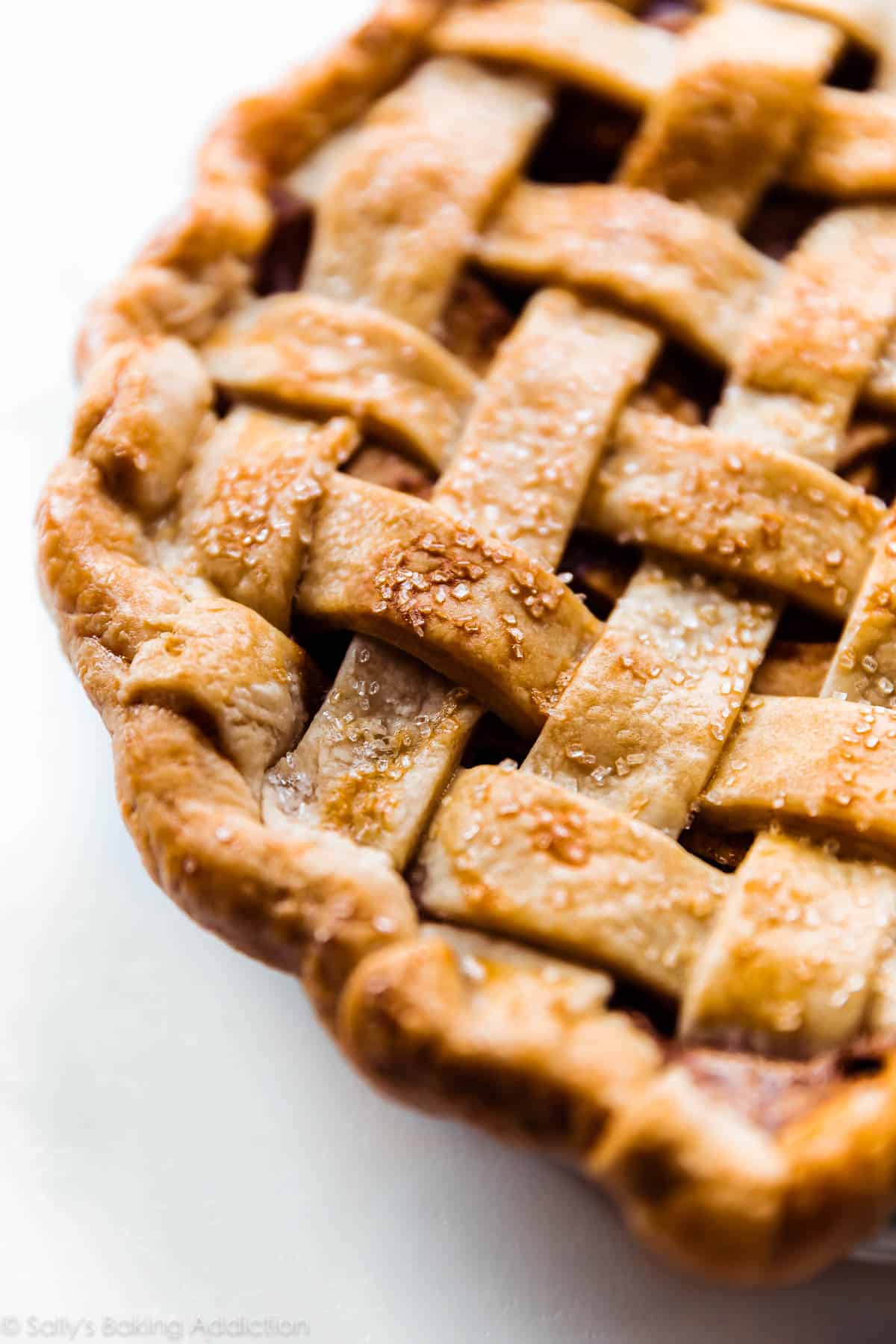
At the request of many, today I’m sharing my go-to all-butter pie crust recipe. It competes with my butter and shortening pie crust for the #1 spot in my pie-loving heart. (Scroll to the recipe notes for my pie crust comparison!) This recipe is such a fan favorite, that it deserved a spot in print! You’ll also find this recipe in my cookbook, Sally’s Baking 101. In the book it’s called Double Pie Crust (and it’s on page 136).
I’ve made thousands of pies in my day and consider myself a pie expert. A pi-expert, if you will. I’ve made all the pie crust mistakes so I can coach you through the process and supply you with all the knowledge and confidence to tackle pie crust once and for all.
You’ll be a pi-expert with this recipe and tutorial on your side!
Watch my video tutorial for butter pie crust with lattice topping. This is my homemade apple pie with chai spices, a favorite every Fall season.
Start with a dependable pie crust recipe and you’re set for success. Soon everyone will be asking YOU for all your pie crust secrets.

Only 5 Ingredients in Butter Pie Crust
This pie crust is made with 5 ingredients. Each ingredient has a very specific job. And with so few ingredients, it’s important to use the best quality.
- Flour – The structure of pie crust.
- Salt – Flavor flavor flavor. Use table salt instead of coarse salt. Smaller salt crystals dissolve and disperse more evenly throughout the dough.
- Granulated Sugar – Pie crust should not be sweet, but adding a little sugar to butter pie crust improves its flavor and enhances browning. The sugar crystals also help break down the hard pieces of butter.
- Cold unsalted butter – Supplies the pie crust’s unbeatable flavor and flaky texture. Use unsalted butter. The amount of salt in different brands’ salted butter varies, so for better control over the flavor, it’s best to begin with unsalted and add your salt.
- Ice water – The final ingredient, about 1/2 cup of ice cold water holds all the ingredients together. Use just enough so the dough holds its shape when rolling out. Many pie crust recipes don’t call for enough ice water, giving you a dry pie dough that cracks when you roll it out. When in doubt, add a little more water. You’re better off with more water (wet pie dough) than not enough water (dry, cracking pie dough) because you can always work more flour into the dough, but you can’t really add water to the pie dough when you’re trying to roll it out.
I use this crust in my apple cheddar pie—there I add some sharp cheddar cheese. It’s also the starting point for chocolate pie crust that we use for chocolate pop tarts!
Basic Pie Crust Steps
- Mix dry ingredients together.
- Cut in the butter with a pastry cutter or food processor.
- Add ice water a little bit at a time until the dough begins to come together. It will feel thick and moist, not overly wet. You’ll use around 1/2 cup (120ml).
- Mold pie dough into a ball.
- Cut in half. This recipe yields two 9-inch pie crusts.
- Flatten into discs. Wrap in plastic wrap.
- Chill for 2 hours before using.
These steps are shown in the video tutorial above and described in the recipe below.
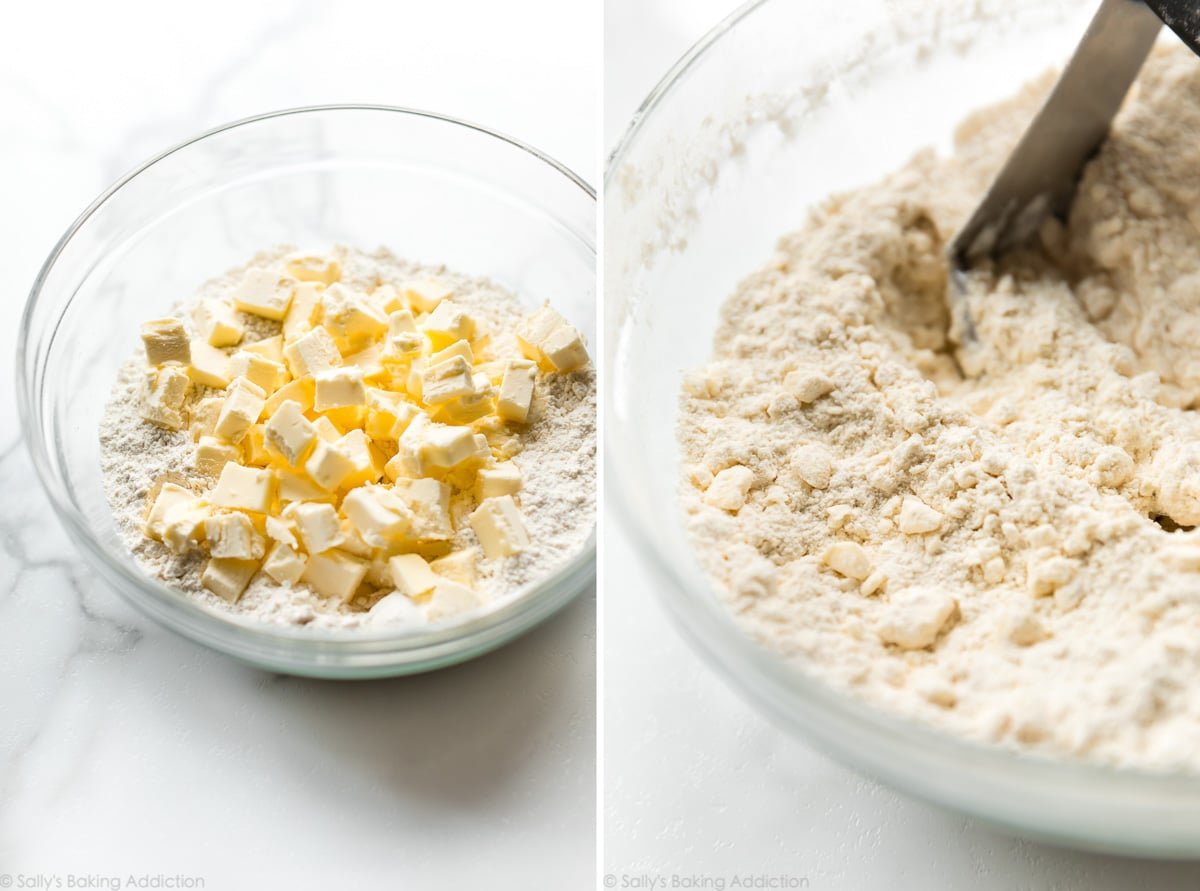
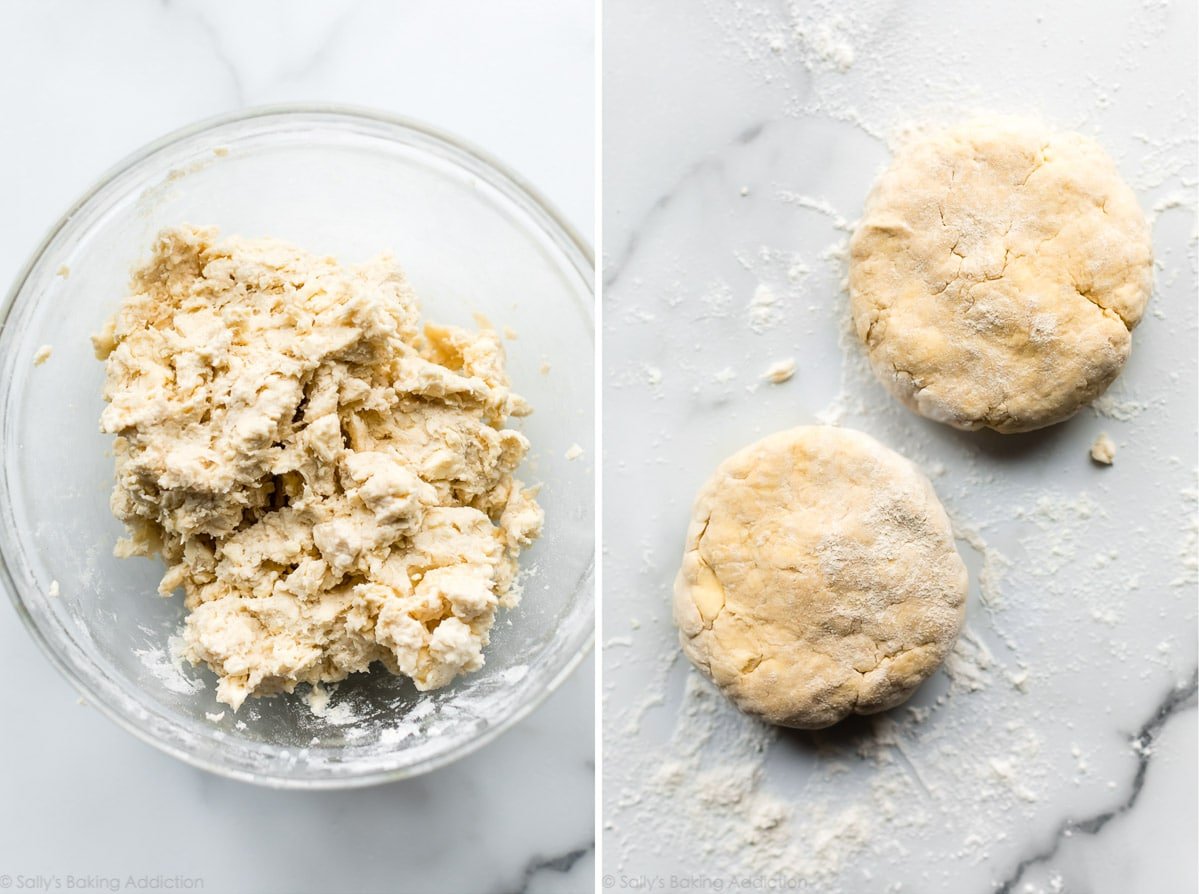
Why the Emphasis on Cold?
Keeping your pie dough as cold as possible prevents the fat from melting too soon. Too soon = before the pie crust enters the oven.
- What happens when the pie dough is warm? The butter in the pie crust will melt before baking, which means you lose all the flakiness and structure. Warm pie dough melts into a pool of grease. You’ll have a hard, crunchy, and greasy crust instead of a beautifully tender flaky crust.
- What happens when the pie dough is cold? The butter in the pie crust will melt inside the oven. Butter has a high volume of water content and this water converts to steam as the pie dough bakes. The steam separates the crust into multiple flaky layers, making this the most delicious pie crust ever.
The colder the dough, the flakier the pie crust.
How to Keep Pie Dough Cold:
- Use ice cold water. Fill a glass with 1 cup of water, add ice. You only need 1/2 cup of water in this butter pie crust recipe, but have a little extra just in case.
- Use cold butter. I keep some of my butter in the freezer and transfer it to the refrigerator a couple hours before beginning the crust. The butter is part frozen and very cold.
- Chill the pie dough for at least 2 hours before rolling out. This step is non-negotiable; it’s the most crucial in the entire pie crust recipe.
- For extra insurance, chill your flour and your mixing bowl in the refrigerator or freezer. Sounds a little silly, but trust me… it really helps!

How to Roll Out Pie Dough
After the dough has chilled, it’s time to roll it out. Keep a small bowl of flour nearby to keep your work surface, rolling pin, and hands lightly floured. This prevents the pie dough from sticking. When rolling pie dough out, always start from the center and work your way out in all directions, turning the dough as you go. If the pie dough feels too warm or the butter is melting, stop. Lift it up, place on a baking sheet, and chill in the refrigerator for at least 10 minutes before continuing.

Butter Pie Crust Tips
- I’m going to repeat myself here. Keep all pie crust ingredients cold. On a hot day, you can chill the measured out flour in the refrigerator or freezer before starting. When taking the pie crust out of the refrigerator to roll out and fill, make sure your pie filling is ready to go. If not, keep the pie crust in the refrigerator until it is.
- Glass pie dishes are best. Why? As opposed to ceramic or metal pie dishes, glass pie dishes conduct heat evenly, which allows the bottom of the crust to bake thoroughly. Also, you can see when the sides and bottom of the crust have browned.
- If your pie recipe requires pre-baking (blind bake pie crust)—let’s say you’re making a pie with an especially wet filling—use pie weights or dried beans. Without pie weights, the pie dough will puff up, then shrink. Whichever you choose, be sure to line the crust with parchment or aluminum foil, then fill the empty pie crust with the weights. See my post and video tutorial for how to blind bake pie crust.
- Always use a pie crust shield. A shield keeps the crust edge covered, which protects it from browning too quickly or worse, burning. Use an adjustable silicone pie crust shield that you can fit to the size of your delicate pie crust. Metal can break the crust. Alternatively, you can cover the pie with a piece of aluminum foil. Cut a large circle in the center of the square so the center of the pie is exposed.
- Learn how to braid pie crust with my how to braid pie crust video tutorial.
- Learn how to lattice pie crust, too.
- Last but not least, learn how to crimp and flute pie crust. Those pretty decorative pie crust edges add function and flair!
Pie Crust Troubleshooting
- Prevent a crumbly pie dough that rips and tears when you roll it out. Make sure you use enough ice water when preparing your pie dough. Too little water creates an unworkable dough.
- Prevent a tough pie crust. Tough crusts are the result of not enough fat in the crust, as well as overworking the dough. Use the all butter pie crust recipe or my shortening and butter pie crust recipe to ensure a flaky, tender pie crust. Additionally, don’t work the dough too much.
- Prevent a burnt crust with a pie shield. See above.
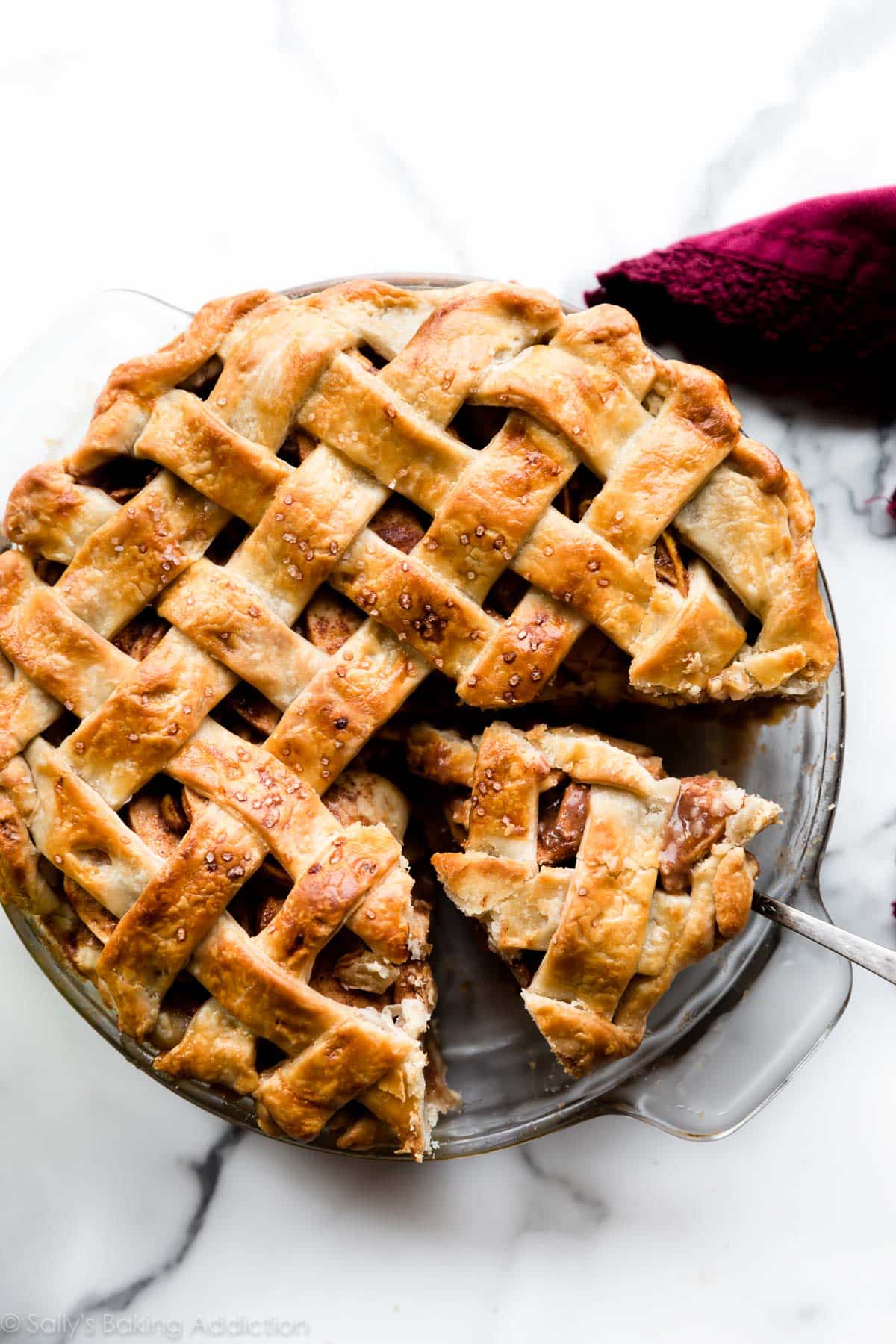
Recommended Pie Crust Tools
(All my recommend products are affiliate links. I trust these tried-and-true tools!)
- Pastry cutter – Though you can use a food processor to make this butter pie crust, I strongly recommend a pastry cutter to avoid over-mixing. Food processors are quick to over-work pie dough.
- Pastry mat – I prefer rolling pie dough out on a lightly floured counter because countertops are usually colder, but you can use a lightly floured pastry mat instead.
- Rolling pin – An obvious must with pie dough! I also love this marble rolling pin. Marble rolling pins are usually cooler to touch and we all know that pie dough loves the cold.
- Glass pie dish – My mother-in-law bought me this Pyrex pie dish 5 years ago and it’s been my go-to ever since. I have 4 of them now! Like I mention in my pie crust tips above, glass pie dishes conduct heat evenly, which allows the bottom of the crust to bake thoroughly. This is important. There’s no comparison, Pyrex is the best.
- Pizza cutter or pastry wheel – To cut your pie dough into strips for lattice decoration or any decoration. Have you seen my pie crust designs post?
- Pastry brush – An egg wash is simply an egg mixed with milk or water (usually milk). Lightly brush the pie dough with an egg wash using a pastry brush. The egg wash creates a golden, shiny, crisp crust. Without it, pie crust is dull and lacking color.
- Pie weights – These are crucial when you blind bake pie crust for no-bake or custard pies. Note: 2 packs of these pie weights is definitely needed!
- Pie crust shield – Pie crust edges are usually higher up than the center of the pie, leaving them exposed to the most heat. They brown quicker than the center of the pie, so it’s important to protect it with a shield. I usually place a pie crust shield on the pie about halfway through bake time. I recommend an adjustable silicone pie crust shield that you can adjust. Or you can cover the pie with a piece of aluminum foil: cut a circle in the center so the center of the pie is exposed.
Pie Recipes
Now that you’re fully prepared and equipped, here are several pie recipes to use your all butter pie crust. Pictured is my chai spice apple pie and I topped it with salted caramel in the video.
- Traditional Apple Pie & Salted Caramel Apple Pie
- Lemon Meringue Pie (a blind bake pie crust recipe)
- Caramel Pear Pie
- Pumpkin Pie
- Pecan Pie
- Banana Cream Pie (a blind bake pie crust recipe)
- Cherry Pie
- Peach Pie
- Blueberry Pie
- Blueberry Peach Pie
- Sweet Potato Pie
- Butterscotch Pie (a blind bake pie crust recipe)
- Fun recipes: Apple Hand Pies, Brown Sugar Cinnamon Pop Tarts, Pecan Pie Tarts
- Or any of my favorite Thanksgiving pie recipes!
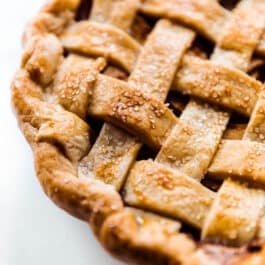
All Butter Pie Crust
- Prep Time: 20 minutes
- Cook Time: 0 minutes
- Total Time: 2 hours, 20 minutes
- Yield: 2 pie crusts
- Category: Pie
- Method: Baking
- Cuisine: American
Description
Follow this simple recipe and video tutorial for the best all butter pie crust. It will make you a pie expert immediately! Complete with all my tips and troubleshooting, this pie crust recipe is buttery, flaky, and tender with the most incredible flavor. This recipe is also in my cookbook, Sally’s Baking 101.
Ingredients
- 2 and 1/2 cups (313g) all-purpose flour, plus more as needed (spooned & leveled)
- 2 teaspoons granulated sugar
- 1 teaspoon salt
- 1 cup (16 Tbsp; 226g) unsalted butter, chilled and cubed
- 1/2 cup (120ml) ice water, plus more as needed
Instructions
- In a large bowl, whisk together the flour, sugar, and salt together. Add the cold cubed butter on top. Using a pastry cutter, food processor, or two forks (pastry cutter is ideal, see post above), cut or pulse the butter into the dry ingredients until it resembles coarse meal. You’re looking for pea-sized bits of flour-coated butter. A few larger bits of butter is OK.
- Drizzle the cold water over the surface of the flour mixture, 1 Tablespoon at a time, and stir after each addition. Stop adding water when the dough comes together easily and begins to form large clumps. The dough will feel moist and a little sticky, but not feel overly wet. Do not add any more water than you need to. I always use about 1/2 cup (120ml) of ice water.
- Transfer the dough to a lightly floured work surface. Using floured hands, gently bring the dough mixture together into a ball. Avoid overworking the dough. If it feels too dry or is too crumbly to form a ball, dip your fingers in cold water and then continue bringing the dough together. If it feels too sticky, sprinkle on a little more flour and continue bringing it together. Using a sharp knife or bench scraper, divide the dough in half. Using your hands, gently flatten each half into a 1-inch-thick disc.
- Wrap each disc tightly in plastic wrap and refrigerate for at least 2 hours and up to 5 days before using in a pie recipe.
- After refrigerating, the dough is ready to roll out and use in a pie recipe. Proceed with the pie per your recipe’s instructions. TIP: When rolling out the chilled pie dough discs, use gentle force with your rolling pin. Start from the center of the disc and work your way out in all directions, turning the dough with your hands between rolls. Smooth out the edges if you notice cracks. (See video.) Keeping your work surface, rolling pin, and hands lightly floured makes rolling out easier.
Notes
- Make Ahead Instructions: Prepare the pie dough through step 4 and freeze the discs for up to 3 months. Thaw overnight in the refrigerator before using in your pie recipe.
- Special Tools (affiliate links): Glass Mixing Bowl | Pastry Cutter | Silicone Spatula | Rolling Pin | 9-inch Glass Pie Dish | Pizza Cutter or Pastry Wheel | Pastry Brush | Pie Weights | Pie Crust Shield
- Pie Crust Comparison: Let’s see how this all butter pie crust recipe compares to my favorite buttery flaky pie crust, which uses a mix of shortening and butter. Due to butter’s high water content, this all butter pie crust is lighter textured with more defined flakes. As the crust bakes, the butter’s water converts to steam, creating thousands of deliciously light flakes. It’s also so buttery! However, because of all this butter, I find that the shortening and butter pie crust is a little easier to work with. Shortening has a higher melting point than butter, so the crust holds its shape wonderfully. Both crusts are fantastic, but if you are looking to make intricate pie crust designs I highly recommend my buttery flaky pie crust.
- Try This: Replacing 1 Tablespoon of ice water with cold apple cider vinegar creates an even flakier, more tender pie dough. It’s so tasty. Try it!

















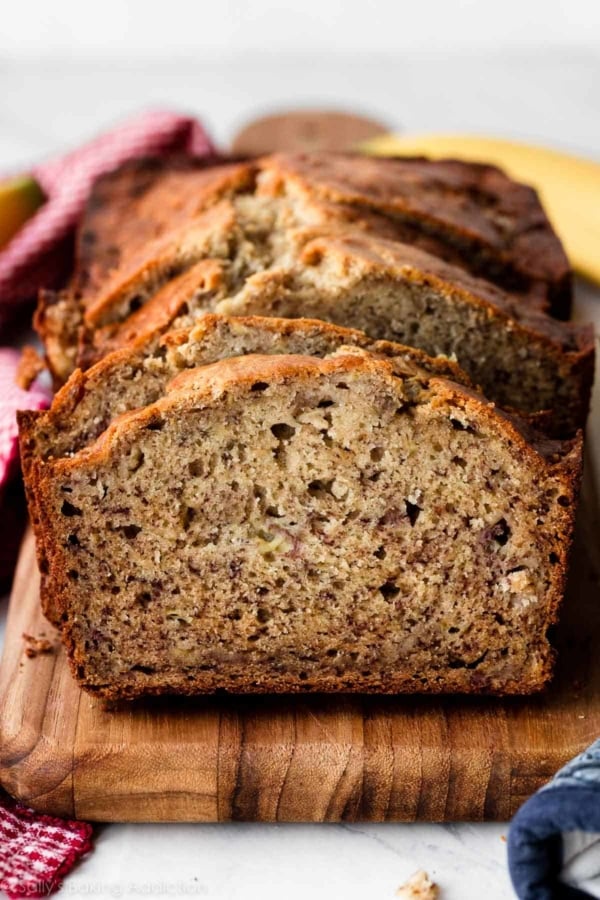

Reader Comments and Reviews
I’ve recently switched to light Morton’s salt will that be ok to use I’ve made thes pie doughs before , amazing kids are requesting more this year for thanksgiving
This is my favorite pie crust recipe!! I’ve been baking it for Thanksgiving every year since middle school. 🙂 Wondering if I wanted to make multiple pies at once, would it be best to double the ingredients or make the dough in two separate batches? Thank you!
Hi Roxie, for best results, we recommend making 2 separate batches rather than doubling. So glad it’s a favorite for you!
Tried this dough and its as straight forward and successful as all her other recipes. Yay!
Woohoo! I finally made a pie crust that turned out perfectly! I always struggle with crusts – I attribute it to the Texas weather, but figured if there was anyone who could help me achieve my flaky pot pie dream, it would be good ole Sally! Thank you Sally! All of your tips are always so helpful and have really changed my baking game. Can’t wait to try the chai apple pie next. Oh, and my daughter loved helping me to “weave” the lattice crust.
Sooooo flaky and good! I made 12 mini pot pies in muffin tin with it. Perfection in 35 mins.
Can I use vegan butter (Miyokos) and gluten free flour in this recipe?
Thank you.
Hi Susan, we haven’t tested either of those swaps, so we’re unsure of the results. Let us know if you do give it a try.
followed the recipe to the letter-and I was skeptical about those 16 tablespoons of butter. While cooking, 20 minutes in, I am seeing just butter bubbling all throughout the pie dish, by this time I would expect the crust to be pretty well cooked. At 25 minutes, it was definitely NOT done. I could see the bottom was still very much uncooked. All in all- this pie was in the oven at 400 for over 30 minutes on convection. One would think that convection would reduce the cooking time due to better air circulation. Even at 30 minutes, the crust was still somewhat underdone on the bottom. And I would say you should add something to the crust or reduce the butter significantly…because while it was flaky, it was not a good tasting crust. It actually took away from the pie (apple) that I used this for. Sorry- I would not recommend this crust
Hi Erin, thank you so much for giving this crust a try and for taking the time to share your detailed feedback. I’m sorry it was disappointing. An all-butter crust does contain a high amount of butter by design, which is what creates those flaky layers, but you shouldn’t see puddles of butter or have an under-baked crust. A couple things that may help: If the butter pieces weren’t cold enough going into the oven, they can melt too quickly before the crust has a chance to set. I recommend chilling the shaped crust well before baking if you can. Convection can sometimes cause uneven browning with pastry, so I typically recommend standard/conventional bake unless otherwise noted. Some bakers also like to blind-bake the crust before filling to help ensure a crisp bottom. Not sure if that is what you were referring to at the 25 and 30 minutes. Apple pies usually take over 50-60 minutes to bake, so I wonder if the pie just wasn’t done yet? Again, not sure if you were blind baking it for 25-30 minutes. Anyway, thank you for your honest feedback.
Made it for some hand pies (the pumpkin hand pies you posted), girlfriend is absolutely obsessed with them. Says the crust is excellent! Was easy to follow, and turned out amazing.
Definitely a returning recipe to my kitchen!!
The recipe sucks, it says you don’t need to pre bake it but you really do. I know it’s not my oven’s problem because it’s new and it Cooks everything else just right. The bottom Crest no matter whether I use a tin or a glass pie dish is never cooked at all you always have to prebake it. I do it for 30 minutes on 385 degrees.
Did you recently add sugar to this recipe? I have made this many times and don’t remember sugar in the recipe.
Hi Amanda, we use this crust as-is for both sweet and savory recipes, but you can leave out the sugar if you wish.
This is the BEST pie crust recipe ever! It works perfectly for gluten-free 1-1 as well! I’ve been baking all my life and never had a pie crust I actually loved… until now! Thank you!!
I love to bake for my family and friends, but am no pro. Curious as to why some choose to make a crust with vinegar and water? I’ve not noticed Sally using that method and womdering why
Hi Kelly, in this recipe, you can replace 1 Tablespoon of ice water with cold apple cider vinegar to create an even flakier, more tender pie dough. We do this often!
We tried this crust with the pumpkin pie and it was amazing!It was very buttery and flakey and delicious.Tasted amazing.We will definitely try it again
Hi sally is it possible to substitute butter for shortening?
Hi Vanessa, we’d recommend using this recipe for pie crust, which uses both shortening and butter. Hope it turns out great!
Hello Sally if we don’t have pastry cutter ? We can knead butter and flour with hands? Bcz u said in food processor it is overgrind
Two forks work great too! You can use a food processor in a pinch – just be very careful not to overwork the dough.
I did mine in the food processor. Just pulse slowly leaving pea size pieces of butter. Crust came out tender, flaky and perfect!
If I wanted to make a pie in a 9×13″ pan, with a top and bottom crust, would this be sufficient?
Hi Ivana, we would double the recipe to have enough crust for a 9×13 pan.
Hi Sally!
I’m hosting and need to make 3 pies. Would it be ok to make and leave the pastry in the fridge for 24 hours before baking?
Thanks
Hi Wagma, yes, you can refrigerate the dough for up to 5 days before using in a pie recipe. Hope it’s a hit!
Does it cost me anything to subscribe? Im new at this.
Hi Donna! No, my website and emails are free.
Do you have any suggestions or modifications when using this recipe for a deep dish pie? It works perfectly for me for a normal pie but I tried using it for a deep dish and I ran out of dough
Hi Phil, you can 1.5x the recipe to make sure you have enough extra for a deep dish pie. You may even have enough extra to do a braid around the edge of the pie, if you want to go all out!
my family favorite! I used this recipe when making my first pie, and it was super easy and absolutely delicious! I strongly recommend after rolling out dough and putting it in pie your pie dish, put it back in the fridge for about 30 mins-1 hour. The temp of the dough gets messed up when rolling out and using your hands!
I refuse to use any other pie crust recipe lol… this is my go to!!!
Can you add sugar to this for sweetness and if so, how much
Hi Carol, you could add 1 Tablespoon of granulated sugar with the dry ingredients.
Am I just missing it or where is the oven temperature and how many minutes??
Hi Kathrin! The baking instructions will depend on what type of pie you’re making. If you’re hoping to fully bake a plain crust, here’s our guide to par-baking pie crusts.
This was my first time making pie crust and it came out great! It was much easier to work with than I expected, and the end result was a super flakey, buttery pie crust. I used a wire avocado masher because I didn’t have a pastry cutter and it worked pretty great lol!
I LOVE this pie crust recipe. It always comes out great! But this time it stuck to the bottom of the dish. Could you tell me why it happened and what I could do to avoid that in the future? I’ve never had this happen before!
Hi Savanna, thanks for trusting this pie crust recipe! We’d recommend making sure that the butter is cut into the flour mixture as well as possible– you want very small and uniform pieces of butter. No large chunks hiding in there!
I have never made a pie crust before, but i just finished making this dough, and now it’s sitting in the fridge! This was so easy and really helped me not feel intimidated as a beginner! We’ll have to see how the pie turns out, but right now im thinking this might become a regular activity for me!!!
proud to report i have made the pie and it is DELICIOUS
I add a tbsp of vodka andwater by tbsp at a time. Awaiting your cookbook to arrive early Sept
Perfect crust!
Do I omit the sugar if I’m using this crust for pot pie? Thanks!
Hi Heather! We use the recipe as-is when we make chicken pot pie.
I have failed at pie crust for years. Used this recipe and made the most beautiful pie! Also, I LOVE that you have metric weights listed as well in your measurements.
I do not have any pie dishes (or any round baking pans either), can I make this pie crust in a round foil pan or should I put it into a rectangle glass dish? (options are 8”x 11” + 9.5” x 13.5”) Thank you so much
Hi Lily! Is the foil pan a pie pan? That should work well!
god forbid someone puts MEASUREMENTS IN A RECIPE
Hi Lilith, you can use the “jump to recipe” button at the top of the page to jump straight to the full written recipe. Hope this helps!
You good girl? This is one of the best websites I’ve found for recipes! She has measurements on every recipe as well as step by step instructions!
I love this recipe, but find that it takes about 1.25-1.5 cups of water to come together nicely. I’ve used it multiple times for chicken pot pie.